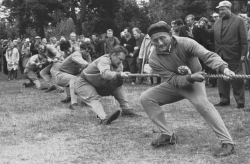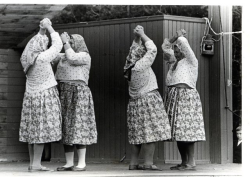Kihnu-Ruhnu games 



Kihnu-Ruhnu games, the biggest cultural and sport event on Kihnu and Ruhnu Islands during the Soviet Period. In 1965-1971 altogether five games between Kihnu and Ruhnu were held alternatively on both islands. At the games, the people of the two islands compared their skills in various sports (running, ball games, discus throw and shot putting, lifting, shooting, swimming, rowing, tug of war), amateur art, handicrafts, fishermen’s multiathlon and quizzes. In addition, they also competed in manufacturing culture, education and public maintenance (for example, in home decorating, ordering newspapers, etc). The island games were first proposed by writer Aadu Hint in the beginning of the 1960s. The winner got a traveling trophy, which was a metal design plate by the artist Salme Raunam depicting two champions competing in cudgel pulling (an old Estonian way of combat) with the sea in the background. For the 1969 games, the last windmill on Ruhnu was restored and Hansu Jürka farm museum was opened in Korsi Farm. Kihnu-Ruhnu Games received wide media coverage and caused excitement both in the Soviet Union and abroad. The main reason for ending the games was the storm of 1969 as a result of which the Ruhnu collective fishing farm was closed down and most of the inhabitants left the island.
The tradition was revived in 2008. The sixth Kihnu-Ruhnu games were held on 16–17 August 2008 on Ruhnu island. The competitions are held every two years alternating between Kihnu and Ruhnu.
Created in 2013







